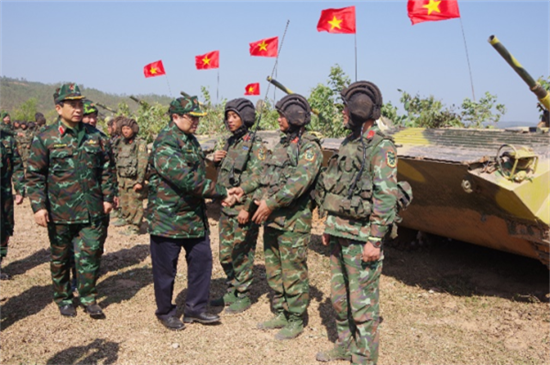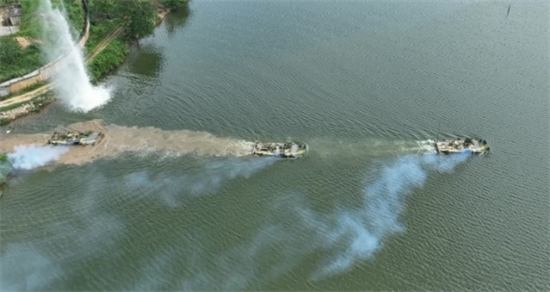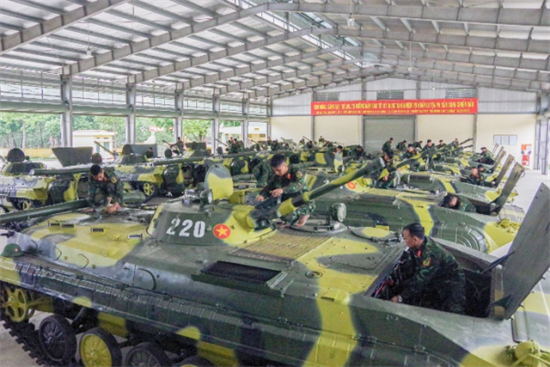Experiences in raising training and combat readiness quality at Mechanised Infantry Division 308
Mechanised Infantry Division 308 is tasked with training and combat readiness within the formation of Army Corps 12 - the first “adept, compact, strong” mobile main corps of our Vietnam People’s Army (VPA).
Based on the functions, assigned tasks, and requirements in the new situation, over the years, the Division’s Party Committee and Command have focused their leadership and direction on taking various synchronised, drastic measures to improve the performance of this routine, central political mission as the basis for raising the Division’s synergy and combat strength. There have been many reforms in training and combat readiness work; targets of training work have all been excellently fulfilled; the Division has gained the title of “Good Training Unit” for many consecutive years; its forces taking part in contests held by the Ministry of National Defence and the Army Corps have achieved excellent results.
 |
| Prime Minister Pham Minh Chinh encourages troops of the Division during DT-23 exercise |
From its recorded results, the Division has drawn several lessons which could be seen as measures for the foreseeable future.
First of all, enhancing all-level party committees and commands’ leadership and direction over training and combat readiness. The Division’s Party Committee and Command, together with party committees and commands of offices and units frequently grasp higher echelons’ resolutions and directives on training and combat readiness, particularly Resolution 1659-NQ/QUTW, dated 20 December 2022, by the Central Military Commission, Resolution 33-NQ/ĐU, dated 15 January 2024, by Army Corps 12’s Party Committee on raising the quality of training in the period of 2023 - 2030 and beyond, and the Army Corps Commander’s Training Order, concretising those documents into targets and measures in their specialised resolutions and training plans properly. After the reorganisation of the Division into a mechanised infantry division, the Division Party Committee supplements targets and measures of leadership and direction relating to the raised quality of training in accordance with the Division’s new structure and task requirements. Offices and units across the Division well carry out political and ideological education work, rendering cadres and soldiers fully aware of the honour and responsibility of being troops of a mechanised infantry unit within the formation of the VPA’s first main mobile army corps, making troops clearly understand missions of the Army Corps and the Division as well as difficulties, challenges, goals, and new requirements in training and combat readiness work.
Notably, the Division regularly improves leadership capacity and combativeness of party committees and party organisations within grass-roots units, enhancing decentralisation in training work, intensifying inspection and supervision, aligning the outcomes of training, exercises, and combat readiness with the task performance evaluation of all-level party committee members and commanders. At the same time, it steps up party and political work and directs the Determined to Win Emulation Movement and the study and following of Ho Chi Minh’s ideology, ethics, and lifestyle towards training content and targets. It adopts various measures to resolutely combat conservative, complacent, or self-satisfied mindsets, manifestations of fear of hardship, and “merit-driven disease” in training. As a result, cadres and soldiers of the Division have achieved great unity in terms of awareness and action, showing great resolve to overcome challenges and successfully accomplish training and combat readiness tasks.
 |
| River crossing by a mechanised infantry unit of the Division during DT-23 exercise |
Second, focusing on preparation for training. The Division directs its offices and units to grasp relevant regulations and guidance and proactively make preparations prior to training. It reviews and adjusts the contingent of cadres in charge of training, particularly within its grass-roots units. At the same time, it designs and organises training and retraining programs for cadres at each level, in a “practical, effective” manner, with a focus on platoon-level, company-level, and new graduate officers, addressing new issues and previous shortcomings, encouraging the sharing of experiences in training. Monthly inspections and evaluations are strictly maintained for each cadre’s training and retraining results. Consequently, all cadres of the Division are now capable of training work at their level; over 90% of battalion-level cadres and more than 80% of company-level and platoon-level cadres are rated as good or excellent in training work.
Additionally, offices and units across the Division concentrate on designing training plans and schedules for each target group, preparing sufficient documents, lesson plans, lectures, facilities, and training models under regulations. They actively apply simulation software, technical innovations, and training equipment initiatives to renew and modernise training work. They regularly inspect, repair, and upgrade their shooting ranges and training grounds, especially ferries, river-crossing sites, and swimming training areas, to ensure durability, long-term use, and suitability with operational conditions and their own realities. On a yearly basis, the Division proactively collaborates with units stationed in the same area to share and utilise specialised training grounds.
Third, actively renewing content and methods of training, maintaining high combat readiness. This measure acts as a deciding factor in raising the Division’s training quality and combat readiness capacity. Thus, the Division directs its offices and units to synchronously, comprehensively carry out training work for target groups under the motto of “basics, practicality, solidity”, emphasise specialised training tailored to tasks and operational areas, focus on practice, proactively adjust and renew content and methods of training, exercises, and testing. As for cadres, they are trained to master staff work for operations and training, to organise and manage training and exercises, to be proficient in information technology, and to step by step improve foreign language skills. Regarding mechanised infantry detachments, they are trained to master new and existing weapons, equipment, and mechanised vehicles, grasp mechanised infantry tactics from squad to battalion levels in different forms of combat, especially in joint operations with other services and corps in hi-tech warfare; importance is attached to camouflage, formation manoeuvre, river-crossing, swimming, and night-time training and combining physical training with long-distance marches.
In the training process, the Division requires its affiliates to adhere to training-related viewpoints, principles, and connections, apply modern methods of training, intensify practice according to each vehicle crew, and align training with the sharing of combat experiences. It employs science and technology in training management, direction, and operation and closely combines training with political education, discipline management, and regularity building. After each training section and stage, it conducts testing and assessment in a close, objective, substantive manner as the basis for drawing lessons for the following stages. It focuses on raising the quality of its exercises, particularly field and live-fire general drills, well performing the work of coordination, and holding refresher courses for directors and detachment-level units prior to an exercise. Notably, it strictly maintains safety regulations during live fire and use of explosives. As a result, in 2024, all training sections of the Division were rated as good, while all-level exercises were successfully held with absolute safety.
Moreover, the Division enhances the work of propagation and education, fostering a sense of responsibility and vigilance among cadres and soldiers during combat readiness duty, strictly maintaining duty regulations from Divisional Headquarters down to its offices and units, especially during national holidays and major political events of the country and VPA. It regularly reviews, adjusts, supplements, and practises combat readiness plans and projects, intensifying irregular and night-time alert exercises, improving its manoeuvrability to avoid passivity in any situations. Offices and units across the Division comply with regulations on ensuring forces, means, and facilities for natural disaster prevention and control as well as for search and rescue.
 |
| Technical Day at Mechanised Infantry Regiment 102 |
Fourth, well performing logistics and technical support work for training and combat readiness. To that end, the Division directs its offices and units to sustain sufficient reserves for combat readiness, guarantee logistics rations for troops during training, exercises, and combat readiness, develop animal and crop husbandry, improve troops’ living standards, well carry out the work of epidemic prevention, and provide medical examination and treatment for their troops to ensure that the rate of healthy troops will always be above 98.5%.
In addition to logistics support, the Division attaches special importance to providing technical support for training, exercises, and combat readiness. Offices and units across the Division strictly abide by regulations on repair and maintenance of weapons and technical equipment, particularly weekly engine start and monthly inspection for vehicles and equipment serving combat readiness and natural disaster prevention. The Division adopts close procedures for receiving, allocating, and disposing of technical equipment, vehicles, machinery, and petroleum, thereby ensuring absolute safety, raising the efficiency of inspection and repair, opportunely detecting and completely handling unexpected breakdowns. Hence, its weapons, equipment, and technical means are regularly maintained with good quality. Besides, it applies information technology in management and operation of technical work, stepping up technical research and innovation, drastically executing the Campaign on “managing and using weapons and technical equipment effectively, sustainably, safely, economically and ensuring traffic safety”.
The cause of VPA building and Fatherland protection is imposing very high requirements on the entire Military. Grasping its assigned tasks, Mechanised Infantry Division 308 will continue further raising the quality of training and manoeuvrability, bringing into play its heroic vanguard tradition in the new era, contributing to firmly protecting the Fatherland in any circumstances.
Sr. Col. NGUYEN NGOC KHANH
Commander of the Division